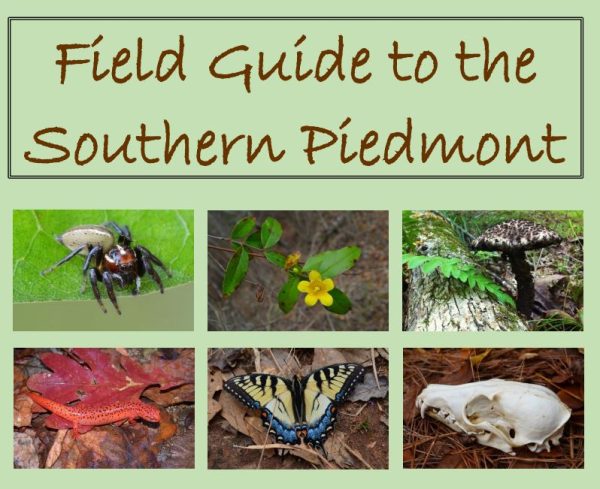This Piedmont field guide will take the mystery out of identifications

Mid-spring is a heady time for naturalists in the Uwharries.
The diversity of flora and fauna often sends us reaching for a field guide. Thanks to Mama’s month-by-month acquisition of the entire Peterson Field Guides series, I have 42 books at my fingertips.
Some we consult on a regular basis: Eastern Birds, Eastern Forests, Eastern Bird Nests, Animal Tracks. We get a kick out of perusing the pages of Venomous Animals. We’ve never cracked the cover of Pacific Shells, Birds of the Caribbean or Northwestern Forests, but if we ever need to identify species in those far flung locations, we know where to turn.
With their gold-embossed leather, the books line up handsomely together on the shelf. We’re reluctant to carry them into the field, lest we subject them to a sudden thunderstorm or leaky water bottle. These days, many naturalists find digital guides more practical. But while it beats lugging multiple books, toggling between apps is distracting. And exhaustive guides on a single subject can be overwhelming, especially for a beginner.

Carolina mantis egg case in Latta Park. Photo: Ruth Grissom.
When I was a novice birder, attending bird walks in New York’s Central Park, I asked the leader which field guide I should buy. Without missing a beat, and without a hint of sarcasm, he replied, “All of them.” While I’ve come to appreciate his wisdom, there’s also something to be said for having a basic, indispensable guide you can turn to again and again.
A budding naturalist in the Piedmont would do well to start with Field Guide to the Southern Piedmont. Browse at your desktop or download onto a mobile device. This free digital guide identifies over 700 species commonly found in the Carolinas and Georgia. It’s the brainchild of Jonathan Storm, assistant professor of biology at the University of South Carolina Upstate.
The idea originated in 2015, when Storm was taking his toddler for hikes in the woods. “I wanted to provide a resource for parents to teach their children about nature in the same manner that I did with my daughter,” he says. He realized a non-technical, picture-based guide – with a coloring book component – could be useful to teachers, students and the general public. For inspiration, he harkened back to the “all-encompassing field guide” he used to identify everything from fossils to plants and animals while growing up on his parents’ farm in Iowa.
Field Guide to the Southern Piedmont is organized into 15 categories. All the usual suspects are present – birds; mammals; reptiles; amphibians; insects; plants; spiders, ticks and mites – as are welcome additions such as tracks, skulls and bones, minerals and rocks, fungi, and lichen. The category devoted to slime molds caught my eye. I’ve never seen the topic covered in a field guide. If the very idea of a slime mold makes you a little queasy, just wait until you read about the species known as dog vomit. It’s yellow and frothy, sometimes spotted with drops of red fluid resembling blood.

Oak bullet galls in Latta Park. Photo: Ruth Grissom.
Anyone who’s been stumped by an oddity that defies search terms will appreciate the category called What’s That? The oblong, ridged lump I spotted on a branch last fall? Voila! A Carolina mantis egg case. That cluster of tiny orbs I saw on a sapling this winter? Oak bullet galls. That’s only one of the half-dozen galls included in the guide. I’m now enthralled with galls! I can also identify various species of wasps and mud daubers based on the architecture of their nests. And the next time I’m in a wetlands habitat, I’ll keep an eye out for a muskrat lodge, which I might have otherwise dismissed as a heap of brush.
The guide even has an auditory component. The final category is called What’s That Sound? This is sometimes the preferred approach when identifying birds, insects, frogs and toads. The birds are organized by likely habitats. Knowing what to expect can be a powerful aid to identification. (To stay current throughout the seasons, follow Southern Piedmont Natural History on Facebook for almost daily posts.)
The guide compiles information from various sources, so it isn’t always specific to the Southern Piedmont. Here, the Uwharries naturalist faces another problem. As a botanist friend once said, species from the mountains and coastal plain “like to slum it” in the Uwharries. The unique combination of location and geology creates niches for species at the edge of their typical range. You might encounter plants, in particular, that aren’t addressed in this guide.
But once you reach that level of proficiency, you’re probably ready for more rarified field guides.